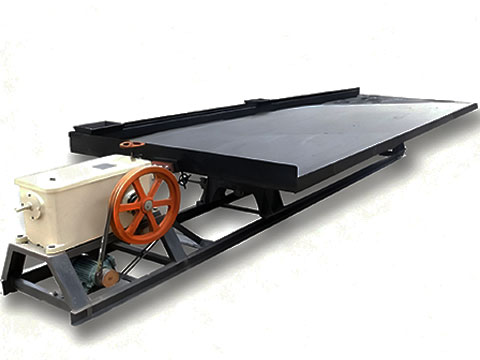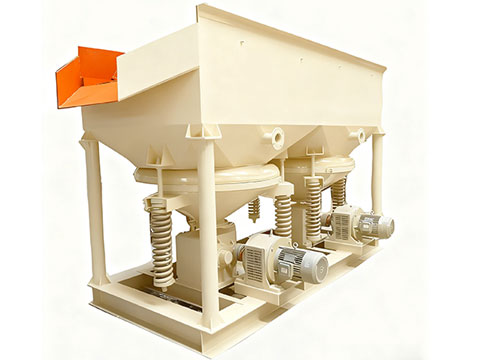
Particle Range: <0.4 millimeters
Application: Mainly used for the sorting of fine-grained materials such as tin, tungsten, gold and silver, lead and zinc, as well as coal. Shaking table can also be used for the recovery of precious metals from waste batteries.
Mineral Shaking Table is a commonly used device for separating fine-grained ores.
Shaking Table typically consists of 3 major components: deck, frame, and transmission mechanism. Additionally, it includes a water flushing tank, feed chute, base, and other parts. The entire deck is supported or suspended by the frame, which is equipped with an adjustable slope device.
Mineral shaking table enables ore particles to move in different directions based on their density and particle size. Starting from the feed chute, the particles spread diagonally in a fan shape and are discharged sequentially along the edges of the deck. The long discharge line allows for precise production of multiple products of varying quality, such as concentrates, middlings, and tailings.
As a gravity separation device, the shaking table has been widely used in the beneficiation of minerals like placer gold and is primarily applied in gold or coal processing.
1. Wide suitable for precise separation of fine-grained materials (e.g., cassiterite, tungsten ore) with a high enrichment ratio.
2. Can effectively process coarse particles above 3 mm and fine particles below 0.4 mm, with typical processing for materials under 1 mm.
3. Simple structure, easy operation, low energy consumption, and economical operating costs due to gravity-based separation.
| Model | Area(㎡) | Feeding Size(mm) | Feeding Density(%) | Capacity(t/h) | Water Volume (m³/t) | Overall Dimensions (mm) | Weight (kg) | ||||
| Coarse Sand | Fine Sand | Mineral Mud | Coarse Sand | Fine Sand | Mineral Mud | ||||||
| LY1100 | 0.51 | 2-0.5 | 0.5-0.074 | 0.074-0.037 | 10-30 | 0.1-0.2 | 0.05-0.1 | 0.03-0.05 | 0.2-0.5 | 1530x500x660 | 350 |
| LY2100 | 2 | 2-0.5 | 0.5-0.074 | 0.074-0.037 | 10-30 | 0.4-0.8 | 0.2-0.5 | 0.1-0.4 | 1-2.5 | 3040x1050x760 | 750 |
| LY3000 | 4.08 | 2-0.5 | 0.5-0.074 | 0.074-0.037 | 10-30 | 0.6-1.5 | 0.3-0.8 | 0.2-0.6 | 1.5-3 | 4130x1680x860 | 1000 |
| LY4000 | 7.67 | 2-0.5 | 0.5-0.074 | 0.074-0.037 | 10-30 | 1-2.5 | 0.8-1.2 | 0.3-0.9 | 2-5 | 5630x1850x860 | 1100 |
Notice: There is a chance that LDHB may make changes on above-mentioned information. Product pictures and parameters about models, data, performances and specifications on this website are for reference only.



